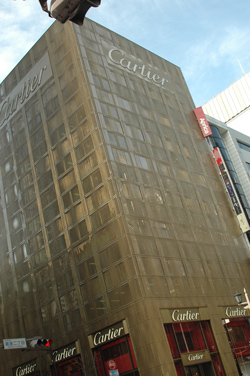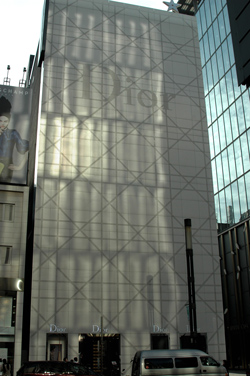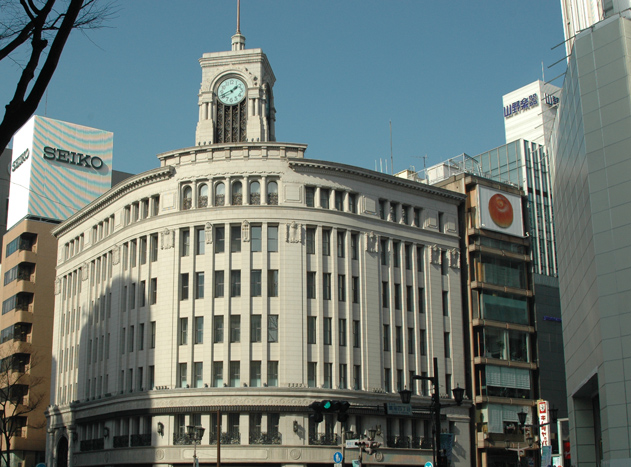Like most iconic Tokyo neighborhoods, Ginza has been reborn countless times over its long, illustrious history. Originally the home of an Edo-era silver coin mint (from which its name is derived), the area first became a shopping district when it was rebuilt in 1872 after a massive fire destroyed nearly all of the traditional Japanese-style wooden buildings. Yet another transformation happened after the Great Kanto Earthquake of 1923, marking the beginning of the neighborhood’s reign as Tokyo’s premier upmarket shopping area.
The late 1920s to 1930s marked the beginning of Ginza’s department store boom, with chains like Mitsukoshi and Matsuya establishing large outlets in the area. To this day the area surrounding Ginza and Yurakucho has one of the highest concentrations of department stores in Japan, although the Yurakucho branch of Seibu department store is due to shutter its doors at the end of the year. Other retail giants that still call the area home include Nagoya-based Matsuzakaya, Paris-based Printemps, and Osaka-based Hankyu.
“To this day the area surrounding Ginza and Yurakucho has one of the highest concentrations of department stores in Japan.”
 The proliferation of department stores led many international luxury fashion houses to open shops in Ginza starting from the middle of the 20th century. Slowly, the historic Georgian Gothic style buildings that were designed by Irish architect Thomas James Walters and had gone up during the 1872 reconstruction were torn down. To replace them came modern structures housing flagship stores of fashion brands such as Hermes, Chanel, Gucci, Cartier and Christian Dior. The most recent of these include Bvlgari and Armani, both of which opened in late 2007.
The proliferation of department stores led many international luxury fashion houses to open shops in Ginza starting from the middle of the 20th century. Slowly, the historic Georgian Gothic style buildings that were designed by Irish architect Thomas James Walters and had gone up during the 1872 reconstruction were torn down. To replace them came modern structures housing flagship stores of fashion brands such as Hermes, Chanel, Gucci, Cartier and Christian Dior. The most recent of these include Bvlgari and Armani, both of which opened in late 2007.
But in 2008 the global financial crisis hit, and since then the most talked-about openings in Ginza have been those of fast-fashion or mass market brands, such as H&M and Uniqlo. December 2009 saw the opening of Japan’s first Abercrombie & Fitch store, a pencil-thin, 11-story tower that is rumored to have been the American sportswear chain’s most expensive yet. Despite the fact that Abercrombie’s style is casual, with an emphasis on jeans, t-shirts, polos and sweatshirts, its prices are decidedly higher than those of its fast-fashion neighbors. It remains to be seen whether or not the mid-priced retailer will prosper amongst Japan’s newly price-conscious shoppers.
 Luxury fashion, however, is by no means dead in Japan. High-end women’s shoe and handbag brand Jimmy Choo opened a Ginza location in the summer of 2008, and on a recent weekday evening there were several shoppers inside trying on sky-high stilettos, even while neighboring stores remained empty. Just a block away lies socialite-turned-designer Tory Burch’s first flagship outside of the US, which opened within days of Abercrombie & Fitch last December. Burch calls her brand “affordable luxury,” with her signature ballet flats selling for ¥29,400 and sunglasses going for ¥21,000.
Luxury fashion, however, is by no means dead in Japan. High-end women’s shoe and handbag brand Jimmy Choo opened a Ginza location in the summer of 2008, and on a recent weekday evening there were several shoppers inside trying on sky-high stilettos, even while neighboring stores remained empty. Just a block away lies socialite-turned-designer Tory Burch’s first flagship outside of the US, which opened within days of Abercrombie & Fitch last December. Burch calls her brand “affordable luxury,” with her signature ballet flats selling for ¥29,400 and sunglasses going for ¥21,000.
As the Japanese economy continues to suffer from reduced spending, it is likely that more stores will begin to follow Seibu’s lead and turn their backs on Ginza—at least for a while. But this can only mean the opening of new, different, and possibly more interesting shops. Ginza, it seems, may just be on the brink of its next rebirth.
photo credits: Kelly Wetherille/ Kevin Jungnitsch









